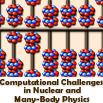Speaker
Constantine Yannouleas
Description
The physics of condensed-matter nanosystems exhibits
remarkable analogies with atomic nuclei. Examples are:
Plasmons corresponding to Giant resonances [1], electronic
shells, de- formed shapes, and fission [2], beta-type decay,
strongly correlated phenomena associated with symmetry
breaking and symmetry restoration [3], etc. Most recently,
analogies with relativistic quantum-field theories (RQFT)
and high-energy particle physics are beeing explored in the
field of graphene nanostructures [4]. The talk will review
these analogies focusing in particular on the following
three aspects: (1) The shell-correction method (SCM,
commonly known as Strutinsky’s averaging method and
introduced in the 1960’s in nuclear physics) was formulated
[5] in the context of density functional theory (DFT).
Applications of the DFT-SCM (and of a semiempirical variant,
SE-SCM, closer to the nuclear Strutinsky approach) to
condensed-matter finite systems will be discussed,
including the charging and fragmentation of metal clusters,
fullerenes, and metallic nanowires [5]. The DFT-SCM offers
an improvement compared to the use of Thomas- Fermi gradient
expansions for the kinetic energy density functional in the
framework of orbital-free DFT. (2) A unified description of
strongly correlated phenomena in finite systems of repelling
particles [whether electrons in quantum dots (QDs) or
ultracold bosons in rotating traps] has been achieved
through a two-step method of symmetry breaking at the
unrestricted Hartree- Fock (UHF) level and of subsequent
symmetry restoration via post Hartree-Fock projection
techniques [3]. The general principles of the two-step
method can be traced to nuclear theory (Peierls and Yoccoz)
and quantum chemistry (L ̈owdin). This method can describe a
wide variety of novel strongly correlated phenomena,
including: (I) Chemical bonding and dissociation in quantum
dot molecules and in single elliptic QDs, with potential
technological applications to solid-state quantum computing.
(II) Particle localization at the vertices of concentric
polygonal rings and formation of rotating (and other less
symmetric) Wigner molecules in quantum dots and ultracold
rotating bosonic clouds [6]. (III) At high magnetic field
(electrons) or rapid rotation (neutral bosons), the method
yields analytic trial wave functions in the lowest Landau
level [7], which are an alternative to the
fractional-quantum-Hall-effect (FQHE) composite-fermion and
Jastrow-Laughlin approaches. (3) The physics of planar
graphene nanorings with armchair edge terminations shows
analo- gies with the physics described by the RQFT
Jackiw-Rebbi model and the related Su-Schrieffer- Heeger
model of polyacetylene [4]. This part of the talk will
describe the emergence of exotic states and properties,
like solitons, charge fractionization, and nontrivial
topological insulators, in these graphene nanosystems. [1]
C. Yannouleas, R.A. Broglia, M. Brack, and P.F. Bortignon,
Phys. Rev. Lett. 63, 255 (1989); [2] C. Yannouleas, U.
Landman, and R.N. Barnett, in Metal Clusters, edited by W.
Ekardt (John-Wiley, New York, 1999) Ch. 4, p. 145; [3] C.
Yannouleas and U. Landman, Rep. Prog. Phys. 70, 2067
(2007), and references therein; [4] I. Romanovsky, C.
Yannouleas, and U. Landman, Phys. Rev. B 87, 165431 (2013);
Phys. Rev. B 89, 035432 (2014). [5] C. Yannouleas and U.
Landman, Phys. Rev. B 48, 8376 (1993); Ch. 7 in ”Recent
Advances in Orbital-Free Density Functional Theory,” Y.A.
Wang and T.A. Wesolowski Eds. (Word Scientific, Singapore,
2013) p. 203 (arXiv:1004.3536); [6] C. Yannouleas and U.
Landman, Phys. Rev. Lett. 82, 5325 (1999); I. Romanovsky,
C. Yannouleas, and U. Landman, Phys. Rev. Lett. 97, 090401
(2006). [7] C. Yannouleas and U. Landman, Phys. Rev. A 81,
023609 (2010); Phys. Rev. B 84, 165327 (2011).

